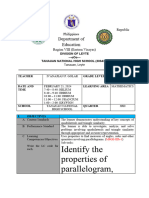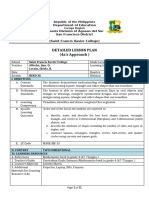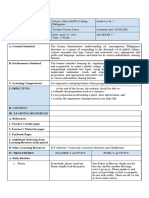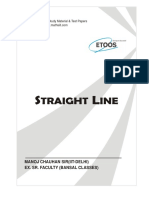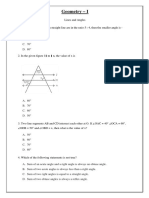Local Demo 2
Uploaded by
jesibel rocoLocal Demo 2
Uploaded by
jesibel rocoRepublic of the Philippines
Commission on Higher Education
Region IV-A CALABARZON
Kolehiyo ng Lungsod ng Lipa
College of Teacher Education
Marawoy, Lipa City
DAILY LESSON PLAN Grade Level NINE (9)
Practice Teacher JESIBEL D. ROCO Learning Area MATHEMATICS
Teaching Date February 28, 2023 Quarter THIRD
I. OBJECTIVES
A. Content Standards
The learner demonstrates understanding key concepts of
parallelograms and triangle similarity.
B. Performance Standards
The learner is able to investigate, analyse, and solve problems
involving parallelograms and triangle similarity through
appropriate and accurate representation.
C. Learning Competency/ Objectives
At the end of the lesson, the students are able to:
prove the theorems of trapezoid and kite.
apply the theorems of trapezoid and kite in solving problems.
display oneness during group activities.
II. SUBJECT MATTER
A. Topic: Midline Theorem
B. References:
Grade 9 Learner's Material pp. 330 – 340
Grade 9 Mathematics: Patterns and Practicalities pp. 398 – 427
PROPERTIES OF TRAPEZOID || GRADE 9 MATHEMATICS Q3
https://www.youtube.com/watch?v=9bmylcUweI4&t=495s
PROPERTIES OF KITE || GRADE 9 MATHEMATICS Q3
https://www.youtube.com/watch?v=GL3Y5nJDMgw
C. Learning Resources:
Visual Aids
Books/online
III. LEARNING TASK
TEACHER’S ACTIVITY STUDENT’S ACTIVITY
A. Preliminary Activities
1. Prayer
Let us all stand. (All students will stand.)
(Teacher will call a student to lead the prayer.)
Let us all remember that we are in the most
holy presence of God as we pray.
In the name of the Father, the Son, and the
Holy Spirit. Amen.
Dear God,
Thank you for this day you have given us.
Lord please adds love and care to each and
every one.
Subtract all the hatred and negativities
surround us.
Competence. Tenacity. Excellence. Page 12
Multiply your good news and mercy on us.
Divide your unending blessings to each of
us.
Dear Lord please grants us the holy spirit to
guide our class today.
All of these, we pray to your most holy
name.
Amen!
2. Greetings
Let say good morning in a unique way!
(Teacher will teach the students how to say
good morning in a unique way.)
Good morning ma’am!
Good morning classmates!
And Mabuhay!
I’m glad to see you again!
3. Classroom Rules
Before you take your seat, kindly arrange
the alignment of your chairs and pick up the
mess under it.
(Students will arrange their chairs and pick
up the mess under it.)
You may now take your sit.
(Students will take their sits.)
4. Checking of Attendance
Class, do we have absent today?
(Students answer may vary.)
5. Review of Past Lesson
Before we proceed to our new topic, let’s have a
short recap of what we have discussed last
meeting. What is the midline theorem?
The segment whose endpoints are the
midpoints of two sides of a triangle is
parallel to the third sides and half as long.
Okay very good!
B. Developmental Activities
1. Motivation
“STAND UP FOR ME”
I have here an activity called “STAND UP
FOR ME”. In this activity I will group you into
two. The first group will be the Trapezoid and
the second group will be the Kite group. I’ll be
flashing pictures, if you think that the picture is
a trapezoid, the first group will stand up and say
their group name (trapezoid). While if the
picture is a kite the second group will stand up
and say their group name (kite).
Is that clear?
Are you ready? Yes ma’am.
(The teacher will start to flash pictures.) Yes ma’am.
1.
Competence. Tenacity. Excellence. Page 12
(Group 1 will stand up and say trapezoid.)
2. B
A C
E
(Group 2 will stand up and say kite.)
D
(Group 1 will stand up and say trapezoid.)
3.
(Group 2 will stand up and say kite.)
4.
(Group 1 will stand up and say trapezoid.)
5.
(Group 2 will stand up and say kite.)
6.
Competence. Tenacity. Excellence. Page 12
Very good! Most of you know the difference
of trapezoid and kite.
2. Activity
Let's have an activity that will reveal the lesson
for today.
HANG MAN
In this game I will call a student to guess a
letter. If you think that you can already guess
what the hidden phrase is, you may raise your
hand and tell your guess. The person who will
guess the phrase correctly will receive a reward.
Is that clear? Yes ma’am.
Are you ready? Yes, we are ready.
(The students will guess a letter as they
were called by the teacher.)
__ __ __ __ __ __
__ __ __ __ __ __ __
__ __
__ __ __ __ __ __ __ __ __ __
__ __ __
__ __ __ __ __ PROVES
THEOREM
ON
TRAPEZOIDS
AND
KITES
Exactly! That is our topic for today.
3. Analysis
Trapezoid
A trapezoid is a quadrilateral in which one
and only one pair of opposite sides is parallel.
The parallel sides of a trapezoid are called
bases. The nonparallel sides are called legs. The
pairs of angles formed by a base and the legs are
called base angles.
Base
Leg Leg
Base Angles
Base
▭ABCD is a trapezoid.
A B
Competence. Tenacity. Excellence. Page 12
D C
∠ D and ∠C are the lower base angles
In trapezoid ABCD, what are the lower base
angles? ∠ A and ∠ B are the upper base angles
How about the upper base angles? AB and DC
What are the bases of the trapezoid ABCD ? AD and BC
What about the legs of the trapezoid ABCD ?
There are two types of trapezoid.
1. Isosceles Trapezoid.
2. Scalene Trapezoid. Isosceles trapezoid have congruent legs.
Based on their name, what do you think are Scalene trapezoid has no congruent legs.
the differences of these two?
Exactly! Let’s give him/her a Showtime Clap. (All students will do the Showtime clap.)
(Teacher will demonstrate how to do the
show time clap.)
If the legs of the trapezoid are congruent,
then the trapezoid is called an isosceles
trapezoid.
Properties of an Isosceles Trapezoid
1. The base angles of an isosceles trapezoid
are congruent.
2. Opposite angles of an isosceles trapezoid
are supplementary.
3. The diagonals of an isosceles trapezoid
are congruent.
100⁰
In the isosceles trapezoid ABCD, if the
m∠ A=100⁰ what will be the measure of ∠ B?
That is correct. Because m∠ A and ∠ B are
the base angle of isosceles trapezoid and it was 100⁰
stated in the property number 1 that the base
angles of an isosceles trapezoid are congruent.
Since m∠ A=100⁰ , therefore m∠ B=100⁰.
Competence. Tenacity. Excellence. Page 12
How about if ∠ D measures 80⁰, what will
be the measure of ∠ B?
Very good! Because m∠ D and m∠ B are
opposite angles of isosceles trapezoid and it was
stated in the property number 2 that opposite
10 cm
angles of an isosceles trapezoid are
supplementary. Since m∠ D=80⁰ , therefore
m∠ B=180⁰ – 80⁰=100⁰.
Now, if AC=10 cm what do you think is the
measure of BD ?
That’s right! Because AC and BD are the
diagonals of isosceles trapezoid and it was
stated in the property number 3 that the
diagonals of an isosceles trapezoid are
congruent.
Let us now move on to the The
Midsegment of Trapezoid.
The midsegment of trapezoid, also called
median, is a segment which joins the midpoints
of the nonparallel sides (legs). It is parallel to the
bases and has a length equal to one-half the sum
of the lengths of the bases.
b 1+b 2
m=
2
Where:
m is the median/midsegment;
b1 is the upper base; and
b2 is the lower base.
B b1 C
E F
BE=5 and AE=5
A b2 D
Given: Trapezoid ABCD. Identify the
following:
a. If BA=10 , BE=¿ ¿ and AE=¿ ¿
Very good! Because point E is the midpoint
of the BA . So to find the measure of the half of
the legs of a trapezoid, all you have to do is to Yes ma’am.
divide the length of the legs in to two. Since BA
is a leg of the trapezoid and point E is the DF =7.5 and CD=15
midpoint, and BA measures 10 unit to find the
Since CF and DF are segment that created in
Competence. Tenacity. Excellence. Page 12
10 CD
measure of BE= =5. Same process to find the the leg of the trapezoid ( ) and the
2 midpoint ( F ), so it means that CF and DF
10 are equal and CD=CF+ DF .
measure of AE , AE= =5.
2
Am I right?
b. If CF=7.5, DF =¿ ¿ and CD=¿ ¿
Bases
Why did you say so?
Median or midsegment.
Exactly! b 1+b 2
m=
2
c. If BC=20 and AD=30, EF =¿ ¿
EF
What part of the trapezoid BC and AD are?
BC
How about the EF ?
20
Since EF is the median of the trapezoid what
formula should we use to get the measure of EF AD
?
30
What is our m?
What is our b1?
And what is the value of BC ?
What is our b2?
And what is the value of AD ?
BC+ AD
EF=
2
20+ 30
EF=
2
50
EF =
2
EF=25
Kite
A kite is a quadrilateral in which exactly one
diagonal is the perpendicular bisector of the
other diagonal. It has also two pairs of
consecutive congruent sides, but opposite sides
is not congruent.
In kite ABCD , AB ≅ BC , AD ≅CD and AB and
BC , AD and CD are two pairs of consecutive
sides.
Competence. Tenacity. Excellence. Page 12
B
A C
D
Properties of Kite
1. Diagonal are perpendicular.
2. Exactly one pair of opposite angles is
congruent.
3. A diagonal bisects each of the non-
congruent angles and other diagonal.
1
4. Area of a kite= (d 1 d 2 )
2
A C
E
115⁰
D
Given : kite ABCD
Diagonal : BD ⟂ AC No
Therefore, ∠ BEC , ∠ BEA , ∠CED and ∠ AEC
measure 90⁰. Because they are not congruent.
Divided into two equal parts.
Opposite Congruent angles: ∠ A ≅ ∠C
Therefore if ∠ A=115⁰, then ∠C will be equal
to?
Non-Congruent: ∠ A ≇ ∠ C
Therefore the measure of ∠ A is NOT equal to
the measure of ∠ C . 8 cm
If ∠ BAD=115⁰, does ∠ BCD will be also
measure 115⁰?
Why?
Competence. Tenacity. Excellence. Page 12
4. Abstraction
To sum it up, what is the trapezoid?
A trapezoid is a quadrilateral in which one
and only one pair of opposite sides is
parallel.
What are the two types of trapezoid and
what are their differences?
There are two types of trapezoid.
1. Isosceles Trapezoid. Trapezoid that has
two equal legs.
2. Scalene Trapezoid. Trapezoid that has no
equal legs.
What are the properties of an isosceles
trapezoid?
Properties of an Isosceles Trapezoid
1. The base angles of an isosceles trapezoid
are congruent.
2. Opposite angles of an isosceles trapezoid
are supplementary.
3. The diagonals of an isosceles trapezoid are
What is the midsegment theorem of congruent.
trapezoid?
The midsegment of trapezoid is a segment
which joins the midpoints of the nonparallel
What is the kite? sides (legs).
A kite is a quadrilateral in which exactly one
diagonal is the perpendicular bisector of the
other diagonal. It has also two pairs of
consecutive congruent sides, but opposite
What are the properties of kite? sides is not congruent.
Properties of Kite
1. Diagonal are perpendicular.
2. Exactly one pair of opposite angles is
congruent.
3. A diagonal bisects each of the non-
congruent angles and other diagonal.
1
4. Area of a kite = (d1d2)
2
5. Application
GREEN LIGHT! RED LIGHT!
I will divide you into four groups. I will be
flashing questions, write your answer on a bond
paper. You are only allowed to start writing
when I say “green light” and you are going to
stop writing and raise your answer as I say “Red
light”.
Is that clear? Yes ma’am?
The group who will get the highest score
will receive a reward.
(The teacher will divide the class and give their
area inside the classroom.) (Each group will form a circle.)
1. What is the formula in getting the measure of
Competence. Tenacity. Excellence. Page 12
the median of a trapezoid? (b1 b 2)
m=
2
2. A trapezoid that has no equal leg. scalene trapezoid
3. It is a quadrilateral in which exactly one
diagonal is the perpendicular bisector of the
other diagonal. It has also two pairs of
consecutive congruent sides, but opposite sides
is not congruent. kite
4. What is the formula in getting the area of a
1
kite? area of a kite = (d d )
2 1 2
5. A quadrilateral in which one and only one pair
of opposite sides is parallel.
trapezoid
6. Trapezoid with two equal legs.
isosceles trapezoid
7. The midsegment of trapezoid are also called
what?
median
8. Opposite angles of an isosceles trapezoid are
____________. supplementary
9. In a trapezoid, how many opposite sides are
parallel? one
10. In a kite, how many opposite sides are
parallel? none
IV. Values Integration
EDUCATION is not always in four corners of a classroom.
-Elmo Edwards
Can anyone in this class share their insight about this statement?
(Student will raise their hand and shares their insight about the statement.)
Education is not only what’s in the book, it’s the things you learn from people and life
experiences. If you hate learning, it’s like you hate living. Do not let your knowledge ends on the
vertices of quadrilateral, explore and enjoy learning outside of it. Do not give up!
V. Evaluation
Direction: On a ¼ sheet of paper, write TRUE if the statement is true and write FALSE if
otherwise.
1. In a kite, only one pair of opposite sides is congruent.
2. The median of a trapezoid is equal to the half of its lower base.
3. The diagonals of a kite are perpendicular.
4. There are three types of trapezoid base on the length of its leg.
5. The diagonals of a trapezoid are perpendicular.
6. The diagonals of a trapezoid are congruent.
7. The diagonals of a kite are congruent.
Competence. Tenacity. Excellence. Page 12
8. The diagonal of a trapezoid bisect each other.
9. Base angles of a trapezoid are congruent.
10. The diagonal of a kite are bisecting each other.
Key to correction:
1. TRUE 6. TRUE
2. FALSE 7. FALSE
3. TRUE 8. TRUE
4. FALSE 9. TRUE
5. FALSE 10. FALSE
VI. ASSIGNMENT
Directions: Name atleast 5 things, can be seen in your home, which are trapezoid or
kites.
Prepared by: Checked by:
JESIBEL D. ROCO ALENNIE MARGARET M. GUADO
Student Teacher Cooperating Teacher
Competence. Tenacity. Excellence. Page 12
You might also like
- Detailed Lesson Plan in Grade 8 Radicals (Multiplication)No ratings yetDetailed Lesson Plan in Grade 8 Radicals (Multiplication)9 pages
- Pinagtonulan Integrated National High School100% (1)Pinagtonulan Integrated National High School8 pages
- -of-Angle-of-Elevation-and-Angle-of-Depression-Pre-FinalNo ratings yet-of-Angle-of-Elevation-and-Angle-of-Depression-Pre-Final10 pages
- 2.1-DETAILED-LESSON-PLAN-ABOUT-FACTORS-AFFECTING-CLIMATESNo ratings yet2.1-DETAILED-LESSON-PLAN-ABOUT-FACTORS-AFFECTING-CLIMATES14 pages
- Detailed Lesson Plan in Mathematics 5 NigNo ratings yetDetailed Lesson Plan in Mathematics 5 Nig6 pages
- LeonardoAlbor - DLP - Solves Corresponding Parts of Congruent Triangles Day 5No ratings yetLeonardoAlbor - DLP - Solves Corresponding Parts of Congruent Triangles Day 511 pages
- R.CARINGAL_DLP1_Union and Intersection of Sets_G7No ratings yetR.CARINGAL_DLP1_Union and Intersection of Sets_G712 pages
- Detailed Lesson Plan in Grade 8 Radicals (Addition and Subtraction)No ratings yetDetailed Lesson Plan in Grade 8 Radicals (Addition and Subtraction)9 pages
- A Detailed Lesson Plan in Mathematics 3No ratings yetA Detailed Lesson Plan in Mathematics 311 pages
- NG The Equation of A Quadratic Function Given Its GraphNo ratings yetNG The Equation of A Quadratic Function Given Its Graph10 pages
- DLP-IN-ENGLISH-IDIOMATIC-EXPRESSIONS (1)No ratings yetDLP-IN-ENGLISH-IDIOMATIC-EXPRESSIONS (1)15 pages
- 5. Plate tectonics, Mobile belt and Pacific ring of FireNo ratings yet5. Plate tectonics, Mobile belt and Pacific ring of Fire9 pages
- Detailed Lesson Plan_Template (KENJI L. SOLIVA)No ratings yetDetailed Lesson Plan_Template (KENJI L. SOLIVA)16 pages
- For More Study Material & Test Papers: Manoj Chauhan Sir (Iit-Delhi) Ex. Sr. Faculty (Bansal Classes)No ratings yetFor More Study Material & Test Papers: Manoj Chauhan Sir (Iit-Delhi) Ex. Sr. Faculty (Bansal Classes)5 pages
- Exercise 20 (A) : Concise Selina Solutions For Class 9 Maths Chapter 20 - Area and Perimeter of A Plane FigureNo ratings yetExercise 20 (A) : Concise Selina Solutions For Class 9 Maths Chapter 20 - Area and Perimeter of A Plane Figure14 pages
- Chapter 4: Mathematical Reasoning Exercise 1: Panitia Matematik Daerah Seremban 2006No ratings yetChapter 4: Mathematical Reasoning Exercise 1: Panitia Matematik Daerah Seremban 20068 pages
- Angle Properties of Polygon & Circles NotesNo ratings yetAngle Properties of Polygon & Circles Notes11 pages
- Congruent Triangles Packet 2013 With Correct Answers1No ratings yetCongruent Triangles Packet 2013 With Correct Answers187 pages
- CONAIP Mathematics Exam With CorrectionsNo ratings yetCONAIP Mathematics Exam With Corrections20 pages
- Sample Question Paper No.1 - Mathematics Time: 3Hrs Max - Marks: 80 InstructionsNo ratings yetSample Question Paper No.1 - Mathematics Time: 3Hrs Max - Marks: 80 Instructions7 pages
- Detailed Lesson Plan in Grade 8 Radicals (Multiplication)Detailed Lesson Plan in Grade 8 Radicals (Multiplication)
- -of-Angle-of-Elevation-and-Angle-of-Depression-Pre-Final-of-Angle-of-Elevation-and-Angle-of-Depression-Pre-Final
- 2.1-DETAILED-LESSON-PLAN-ABOUT-FACTORS-AFFECTING-CLIMATES2.1-DETAILED-LESSON-PLAN-ABOUT-FACTORS-AFFECTING-CLIMATES
- LeonardoAlbor - DLP - Solves Corresponding Parts of Congruent Triangles Day 5LeonardoAlbor - DLP - Solves Corresponding Parts of Congruent Triangles Day 5
- Detailed Lesson Plan in Grade 8 Radicals (Addition and Subtraction)Detailed Lesson Plan in Grade 8 Radicals (Addition and Subtraction)
- NG The Equation of A Quadratic Function Given Its GraphNG The Equation of A Quadratic Function Given Its Graph
- 5. Plate tectonics, Mobile belt and Pacific ring of Fire5. Plate tectonics, Mobile belt and Pacific ring of Fire
- Teacher Guide for KC Adams' Perception: A Photo SeriesFrom EverandTeacher Guide for KC Adams' Perception: A Photo Series
- For More Study Material & Test Papers: Manoj Chauhan Sir (Iit-Delhi) Ex. Sr. Faculty (Bansal Classes)For More Study Material & Test Papers: Manoj Chauhan Sir (Iit-Delhi) Ex. Sr. Faculty (Bansal Classes)
- Exercise 20 (A) : Concise Selina Solutions For Class 9 Maths Chapter 20 - Area and Perimeter of A Plane FigureExercise 20 (A) : Concise Selina Solutions For Class 9 Maths Chapter 20 - Area and Perimeter of A Plane Figure
- Chapter 4: Mathematical Reasoning Exercise 1: Panitia Matematik Daerah Seremban 2006Chapter 4: Mathematical Reasoning Exercise 1: Panitia Matematik Daerah Seremban 2006
- Congruent Triangles Packet 2013 With Correct Answers1Congruent Triangles Packet 2013 With Correct Answers1
- Sample Question Paper No.1 - Mathematics Time: 3Hrs Max - Marks: 80 InstructionsSample Question Paper No.1 - Mathematics Time: 3Hrs Max - Marks: 80 Instructions













